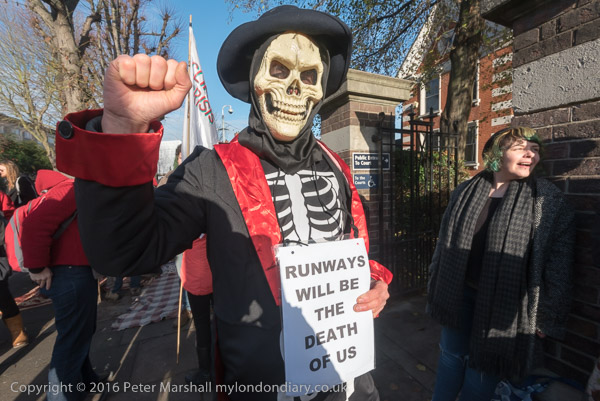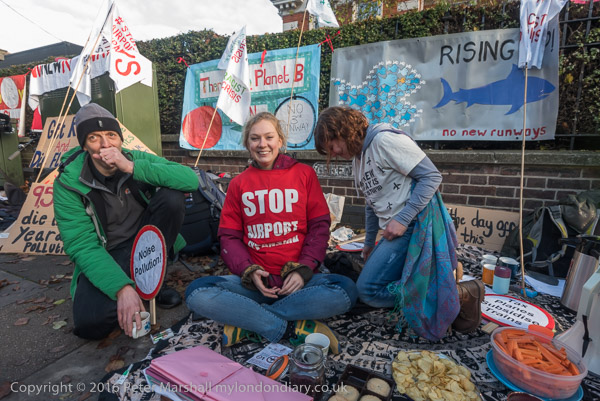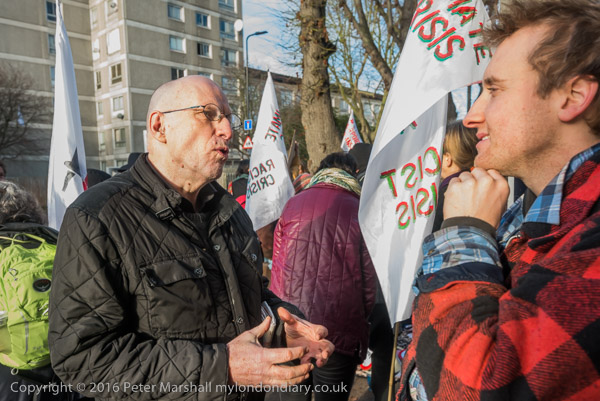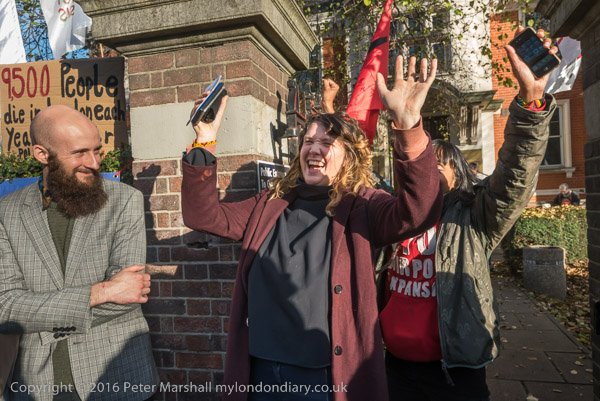
People often say things about it being a nice day to take photographs when its bright and sunny with a clear blue sky, but such days, welcome though they are for other reasons, especially in winter, are ones that photographers dread, with sun from a low angle, deep shadows and ridiculous contrast.

And December 22nd was one of those days, and I left home knowing things were likely to be tricky as I walked to the station. The trial of the Rising Up “M4-15” who had blocked the motorway spur into the airport in a protest against Heathrow expansion was taking place at Ealing Magistrates Court, and a protest in solidarity was starting there rather early in the morning.

I seldom do early mornings. For me its one of the perks of being my own boss and doing what I like to have a reasonably leisured start to the day, and in any case catching an early train doubles the fares. I decided arriving a little after 10am would be plenty early enough, and although the protest had been going for a while I hadn’t missed anything of importance. Many of those coming to the event had made a similar assumption too.
While there were a few things to photograph, the event only really got going later, and like almost everything to do with courts there was a lot of waiting around. And waiting around.

John Stewart’s head could have done with a little less exposure
You can see my problems with the light in a few pictures. Some of them could have been solved by using fill-flash, but others it would have created worse problems, so although I’d had the flash in my bag I hadn’t used it. There are some situations where the flash creates a very different atmosphere and this event, largely very informal, was one of them.
I like to keep things technically as simple as possible when I’m taking pictures, and the Exif data on every picture I took reads Mode: P, Meter: Matrix, No Flash, Auto WB. It’s mainly amateurs who express surprise that I usually work using Program mode, but it works and the dial under my thumb lets me chose a faster speed or a slower one for a wider aperture should I think it necessary. 99% of the time it gives the result I want without my having to pause and think about it.
Nikon’s matrix metering is pretty good too, though I usually have a third of a stop underexposure set to keep a little more of the highlights, I should probably have made that two or even three thirds for the high contrast light, as just occasionally I lost important highlights. Shadows don’t matter much as there is always more you can dig out from the RAW file in Lightroom.
I do sometimes use spot metering (or at least what Nikon call spot.) Back in the days of film I used it most of the time, both the spot metering of the Olympus OM system (surely the OM4 remains the best camera of all time for exposure metering) and also a handheld spot meter, because you needed to be precise, especially with transparency film, and even with black and white I enjoyed placing the key value on the Zone where I wanted it. But spot metering requires you think about it, and when you forget to change back to matrix produces some very uneven results, as I’ve too often proved.
Technically, digital cameras are almost certainly more clever than I am and, so long as you keep the highlights, allow you to play almost infinitely back on the PC with print exposure and contrast. I’m happy to put the camera on P and do that stuff while I concentrate on content and framing. As I’ve often joked, ‘P’ stands for Professional.
Eventually the 14 defendants had to go into court and those of us who didn’t want to go in with them were left standing outside. I don’t like having to hand all my camera gear over so I stayed out. And waited.
Not for all that long, as courts break early for lunch, and the defendants came out and some spoke. They were in good spirits as they felt things had gone well for those who had pleaded guilty but whose solicitor had been allowed to make clear that they were “but only guilty of standing up to climate injustice”.

I’d been hanging around long enough and left when they went back into court and only heard the verdict and sentences later in the day. The 12 who pleaded guilty were all given ‘conditional discharges’, and had to pay £20 victim surcharge and £85 prosecution costs. The cases of the two who had pleaded ‘not guilty’ were adjourned. The Daily Mail clearly didn’t like the verdict, but would probably not have been satisfied with anything less than them being hung, drawn and quartered.
See more at Heathrow “M4-15″protesters at court
______________________________________________________
There are no adverts on this site and it receives no sponsorship, and I like to keep it that way. But it does take a considerable amount of my time and thought, and if you enjoy reading it, a small donation – perhaps the cost of a beer – would be appreciated.
My London Diary : Buildings of London : River Lea/Lee Valley : London’s Industrial Heritage
All photographs on this and my other sites, unless otherwise stated, are taken by and copyright of Peter Marshall, and are available for reproduction or can be bought as prints.
To order prints or reproduce images
________________________________________________________